sunrise colors vs sunset colors
Eye-catching sunrises and sunsets also seem to favor certain times of the year. In the middle latitudes and over the eastern half of the United States, for example, fall and winter generally produce the most spectacular low-sun hues.
Why do some parts of the world enjoy more beautiful sunsets than others, and why do they favor certain months? What are the ingredients for truly memorable sunrises and sunsets? These and other twilight topics are explored in the paragraphs that follow...
What dust and pollution don't do
It is often written that natural and manmade dust and pollution cause colorful sunrises and sunsets. Indeed, the brilliant twilight "afterglows" that follow major volcanic eruptions owe their existence to the ejection of small particles high into the atmosphere (more will be said on this a bit later). If, however, it were strictly true that low-level dust and haze were responsible for brilliant sunsets, cities such as New York, Los Angeles, London, and Mexico City would be celebrated for their twilight hues. The truth is is that tropospheric aerosols --- when present in abundance in the lower atmosphere as they often are over urban and continental areas --- do not enhance sky colors --- they subdue them. Clean air is, in fact, the main ingredient common to brightly colored sunrises and sunsets.
To understand why this is so, one need only recall how typical sky colors are produced. The familiar blue of the daytime sky is the result of the selective scattering of sunlight by air molecules. Scattering is the scientific term used to describe the reflection or re-direction of light by small particles. Scattering by dust or by water droplets is responsible for the shafts of light that appear when the sun partly illuminates a smoky room or mist-laden forest. Selective scattering, also known as Rayleigh scattering (after the nineteenth century English physicist Lord Rayleigh), is used to describe scattering that varies with the wavelength of the incident light. Particles are good Rayleigh scatterers when they are very small compared to the wavelength of the light.
Ordinary sunlight is composed of a spectrum of colors that grade from violets and blues at one end to oranges and reds on the other. The wavelengths in this spectrum range from .47 um for violet to .64 um for red. Air molecules are much smaller than this --- about a thousand times smaller. Thus, air is a good Rayleigh scatterer. But because air molecules are slightly closer in size to the wavelength of violet light than to that of red light, pure air scatters violet light three to four times more effectively than it does the longer wavelengths. In fact, were it not for the fact that human eyes are more sensitive to blue light than to violet, the clear daytime sky would appear violet instead of blue!
At sunrise or sunset, sunlight takes a much longer path through the atmosphere than during the middle part of the day. Because this lengthened path results in an increased amount of violet and blue light being scattered out of the beam by the nearly infinite number of scattering "events" that occur along the way (a process collectively known as multiple scattering), the light that reaches an observer early or late in the day is noticeably reddened. Thus, it could be said that sunsets are red because the daytime sky is blue. This notion is perhaps best illustrated by example: A beam of sunlight that at a given moment helps produce a red sunset over the Appalachians is at the same time contributing to a deep blue, late afternoon sky over the Rockies (Figure 1).
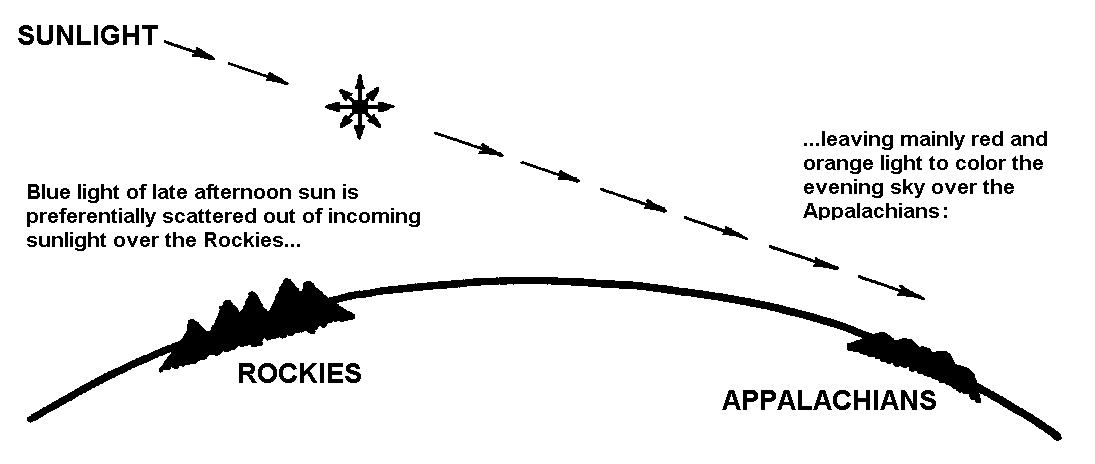
Now what happens when airborne dust and haze enter the view? Typical pollution droplets such as those found in urban smog or summertime haze are on the order of .5 to 1 um in diameter. Particles this large are not good Rayleigh scatterers as they are comparable in size to the wavelength of visible light. If the particles are of uniform size, they might impart a reddish or bluish cast to the sky, or result in an odd-colored sun or moon (it is this effect that accounts for the infrequent observation of "blue suns" or "blue moons" near erupting volcanoes). Because pollution aerosols normally exist in a wide range of sizes, however, the overall scattering they produce is not strongly wavelength-dependent. As a result, hazy daytime skies, instead of being bright blue, appear grayish or even white. Similarly, the vibrant oranges and reds of "clean" sunsets give way to pale yellows and pinks when dust and haze fill the air.
But airborne pollutants do more than soften sky colors. They also enhance the attenuation of both direct and scattered light, especially when the sun is low in the sky. This reduces the total amount of light that reaches the ground, robbing sunrises and sunsets of brilliance and intensity. Thus, twilight colors at the surface on dusty or hazy days tend to be muted and subdued, even though purer oranges and reds persist in the cleaner air aloft. This effect is most noticeable in an airplane, shortly after take-off on a hazy evening: A seemingly bland sunset at the ground gives way to vivid color aloft as soon as the plane ascends beyond the haze. When the haze layer is shallow, a similar effect sometimes is evident at the surface, as shown by the sunset sequence in Figure 2. The photographs show a sheet of billowed altocumulus that erupts into a blaze of fiery oranges and reds once the sun has dropped far enough below the horizon that it no longer directly illuminates the thin veil of surface-based haze present below the clouds. The haze layer appears as a dark band just above the horizon in the last (enlarged) view.
| | | |
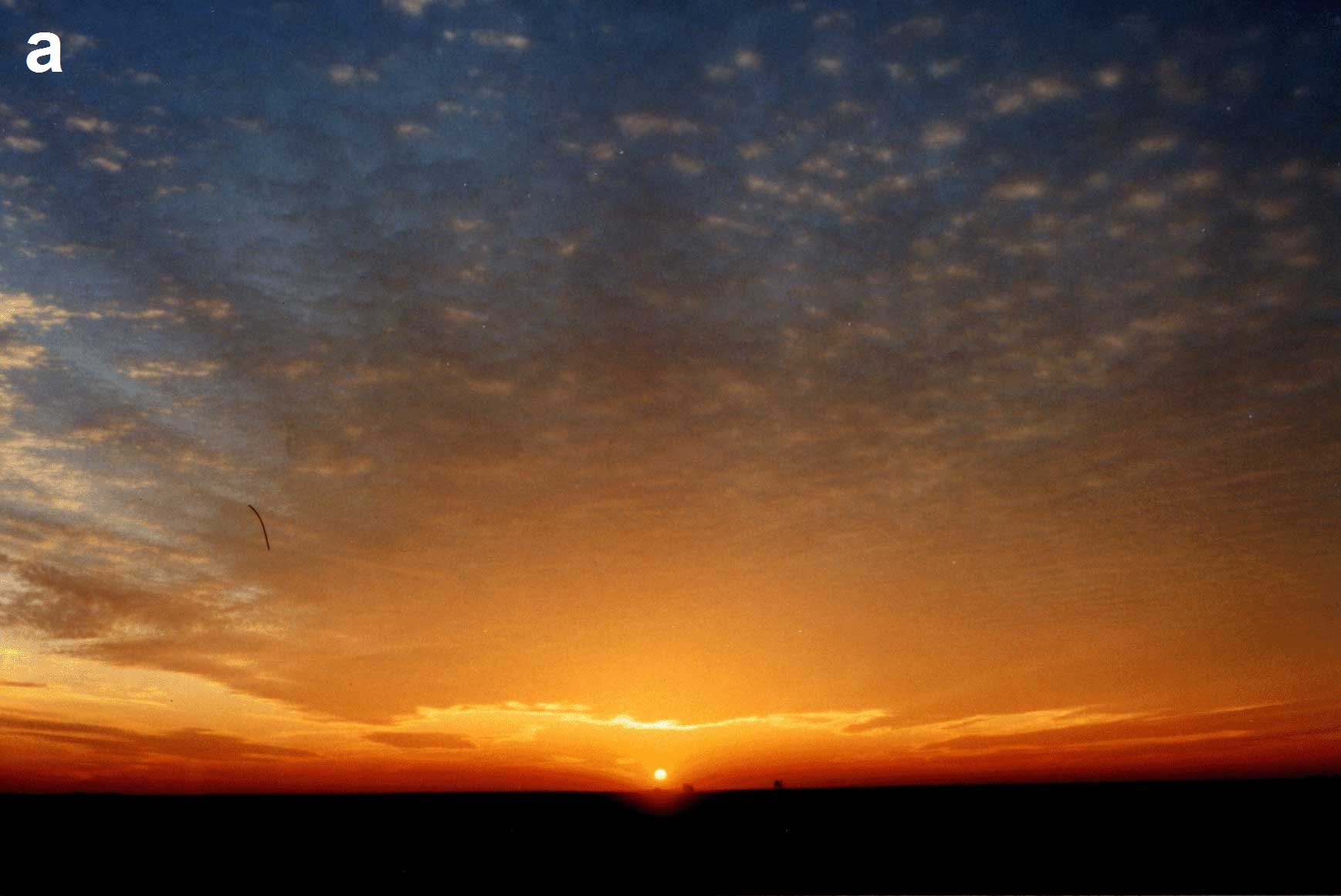 | 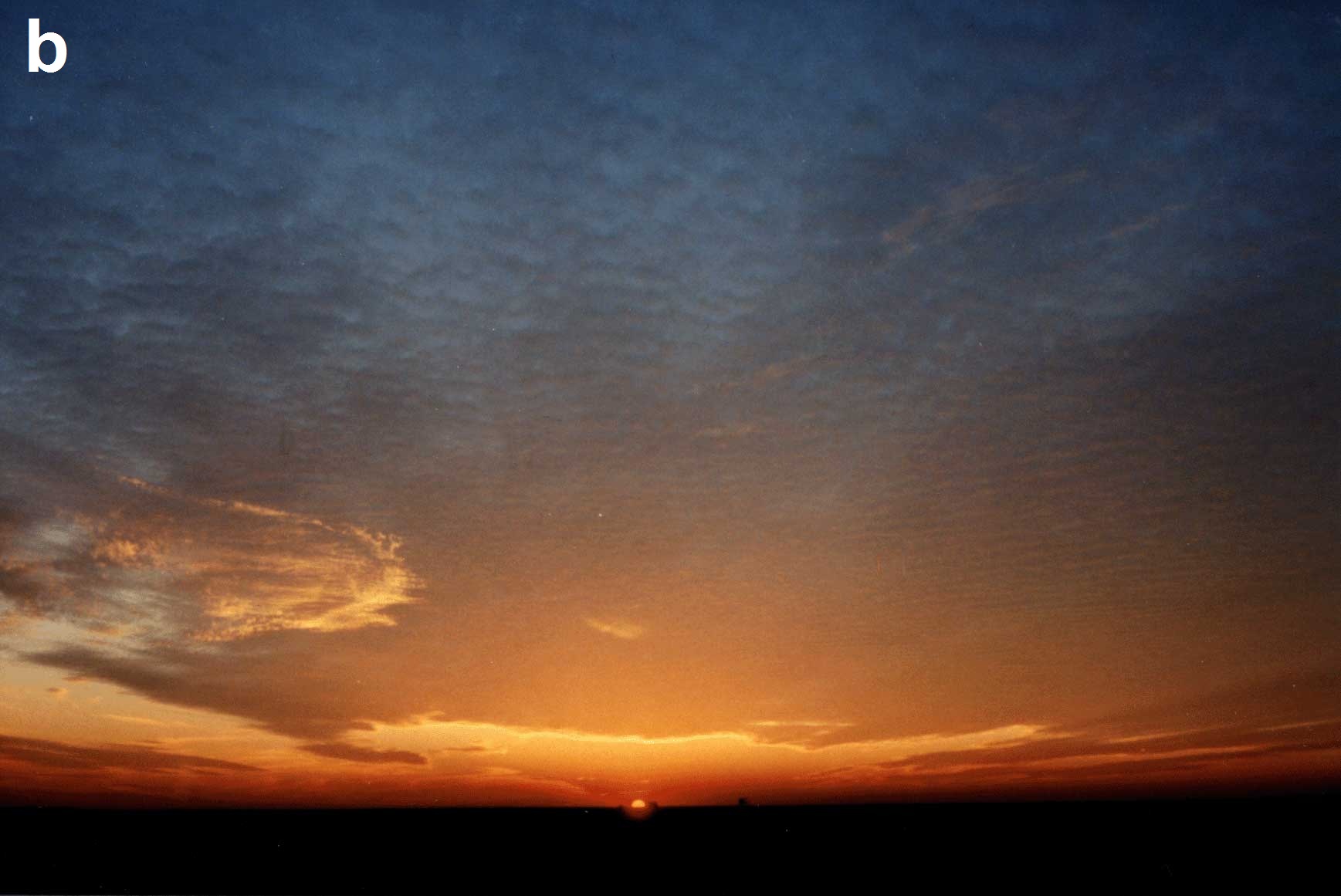 | 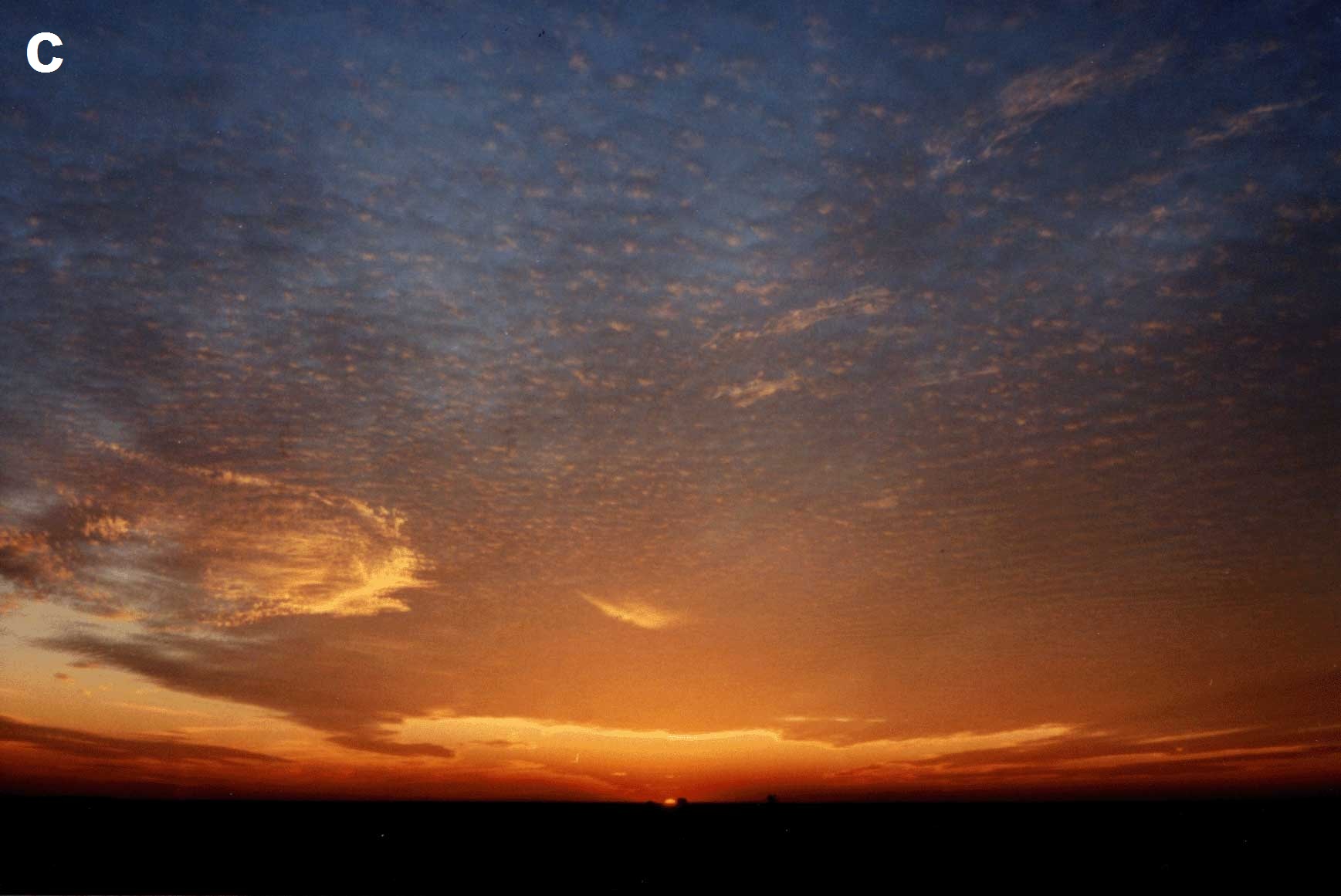 |
 |  | 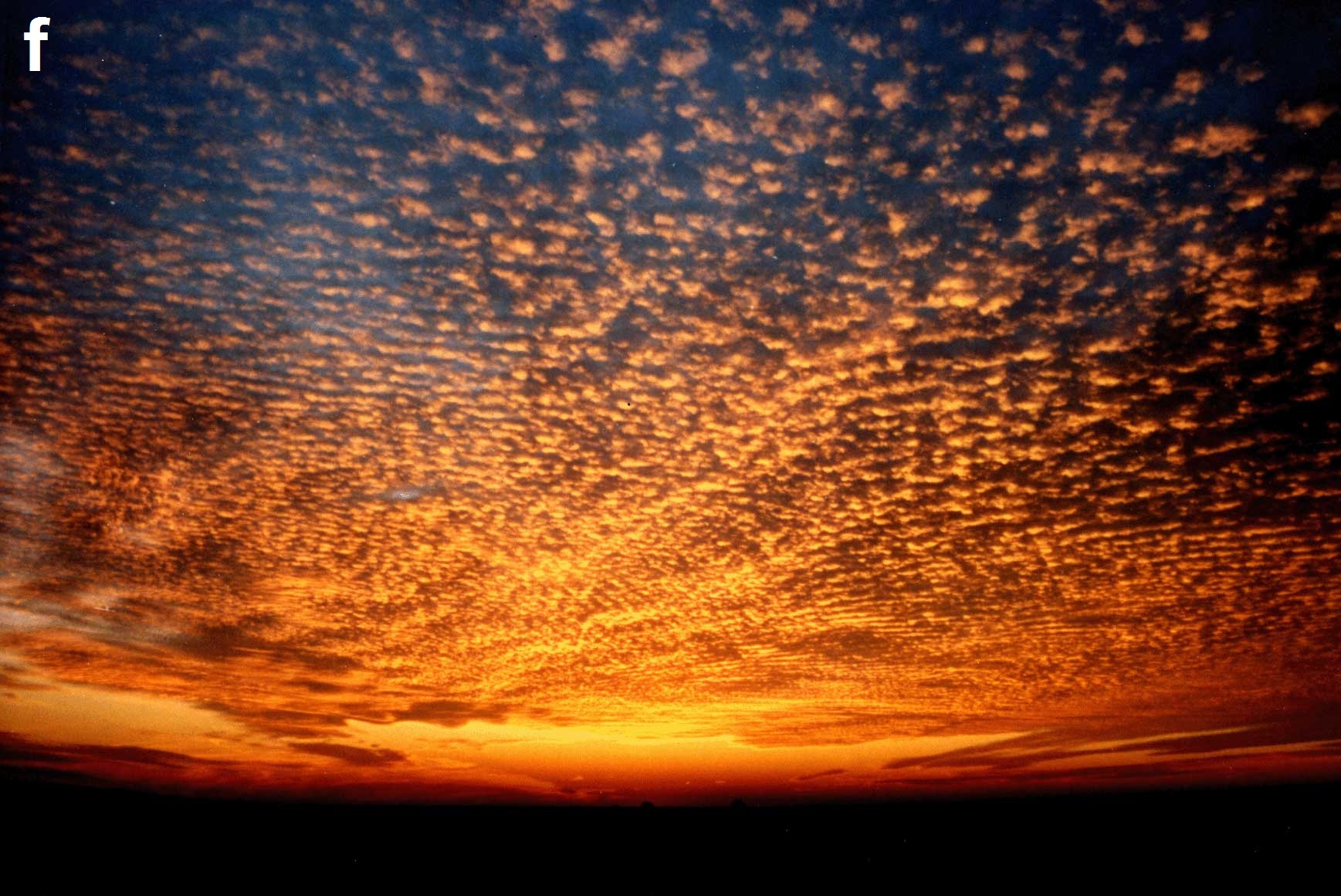 |
| |
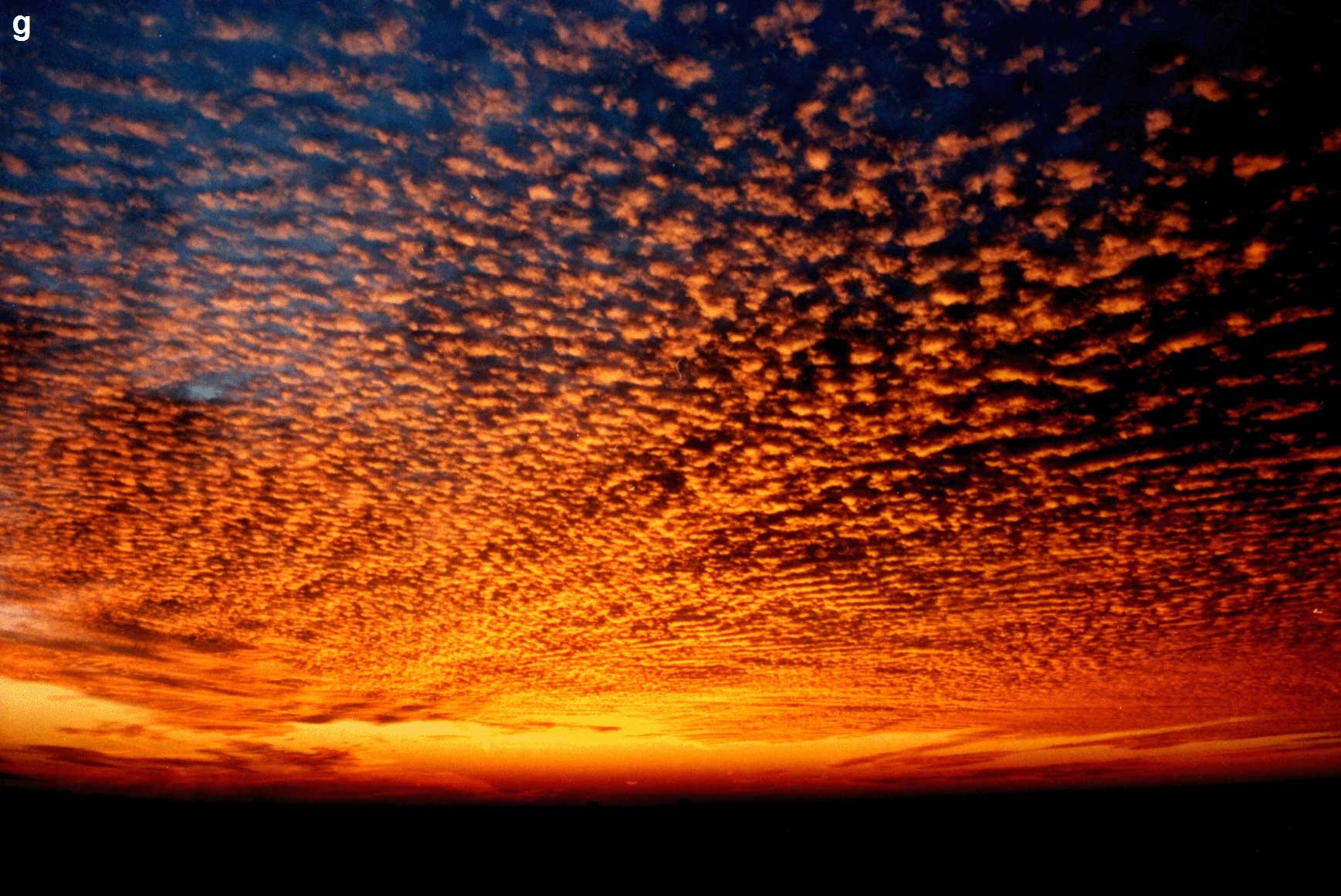
The role of clouds
Although the twilight sky can certainly inspire awe even when it is devoid of clouds, (e.g., Figure 3, with the crescent moon at left), the most memorable sunsets tend to be those with at least a few clouds. Clouds catch the last red-orange rays of the setting sun and the first light of the dawn like a theatre screen, and reflect this light to the ground. But certain types of clouds are more closely associated with eye-catching sunsets than others. Why?
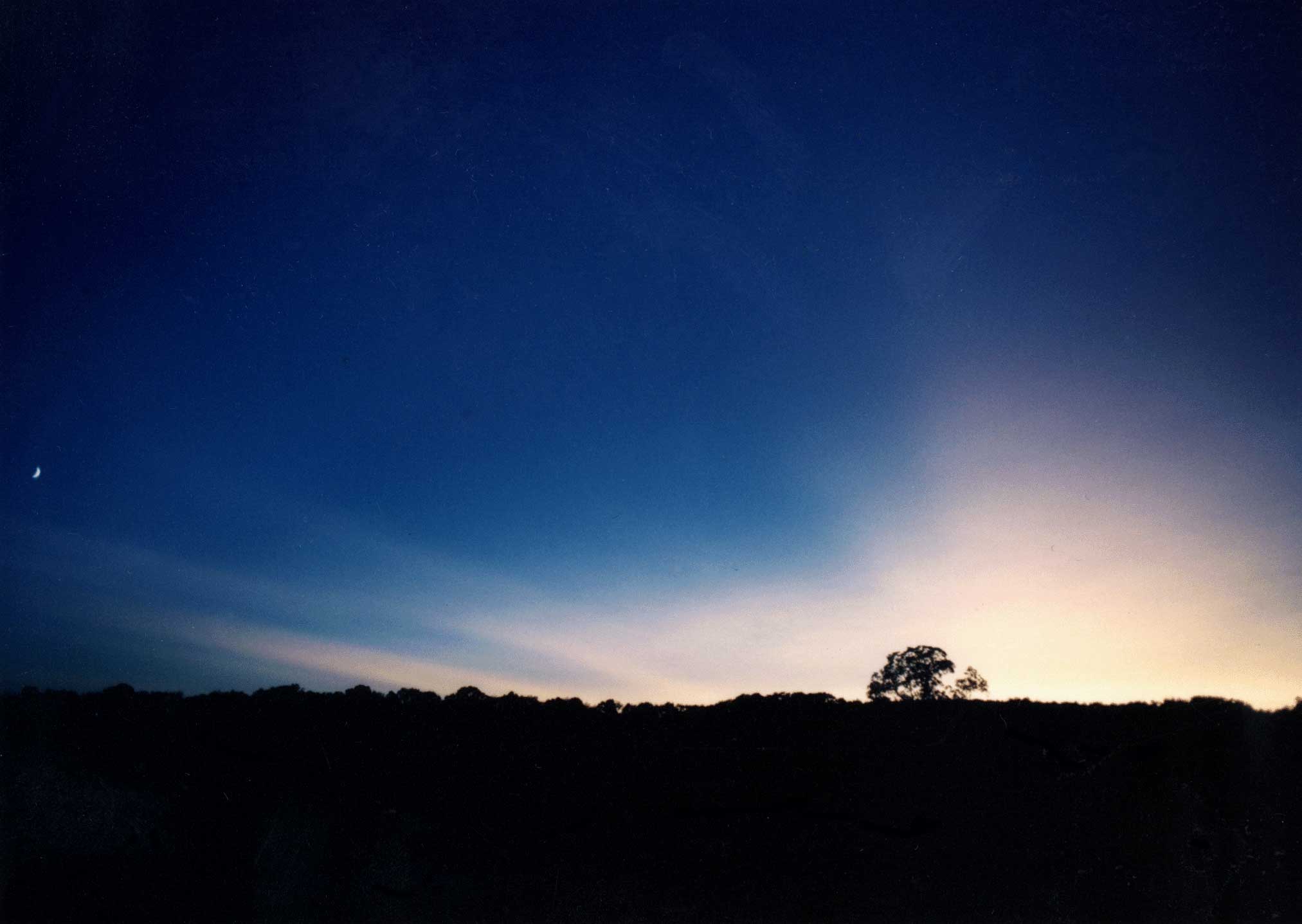
To produce vivid sunset colors, a cloud must be high enough to intercept "unadulterated" sunlight...i.e., light that has not suffered attenuation and/or color loss by passing through the atmospheric boundary layer. (The boundary layer is the layer near the surface which contains most of the atmosphere's dust and haze). This largely explains why spectacular shades of scarlet, orange, and red most often grace cirrus and altocumulus layers, but only rarely low clouds such as stratus or stratocumulus. When low clouds do take on vivid hues, as they often do over the open ocean in the tropics, it is a clue that the lower atmosphere is very clean and therefore more transparent than usual.
Some of the most beautiful sunrises and sunsets feature solid decks of middle or high clouds that cover the entire sky except for a narrow clear strip near the horizon. A five-minute sequence of such a sunset over Baltimore, Maryland is shown in Figure 4. In the middle latitudes, skies like these often are associated with a passing jet stream disturbance; i.e., they mark the zone of transition between west-to-east moving regions of atmospheric ascent (cloud cover) and descent (clear skies). When viewed at sunrise, a sky of this type implies that the weather is likely to deteriorate as the mid- and upper-level moisture continues eastward. At sunset, of course, the opposite is true, hence the saying "Red sky at night, traveler's delight; Red sky in morning, traveler take warning."
Sunsets like the one in Figure 4 are perhaps most notable for the "bathed in red" effect that they produce. The entire landscape takes on a surreal saffron hue as the clouds reflect the fading sun's red and orange glow, allowing very little blue (scattered) light from the upper levels of the atmosphere to reach the ground. This particular example also illustrates how large particles --- in this case rain drops falling from the departing upper level cloud deck in the left-most view (a) --- tend to mute sunset colors. The overall coloration at this point is a dusky brownish-orange. Minutes later, once the rain has cleared the area, vibrant shades of red and orange overspread the scene (image c).
Certain cloud forms also characteristically assume shapes and textures that add interest. For example, altocumulus layers typically occur at inversions, where the wind often changes speed and/or direction with height. This change in the wind (known as wind shear) can give rise to wave-like or roller motions that are manifested as cloud "ripples" or "billows." The grazing illumination of the low sun on such formations can create spectacular cloud scapes that change over time as the angle of illumination changes (e.g., Figure 2). Elevated cumuliform clouds such as those in Figure 4 also add interest, as the vertical extent of the clouds and their trailing precipitation cascades (fallstreaks) result in gradations of lighting that are not as easily realized in more uniform cloud decks.
Another reason some cloud forms more commonly are associated with memorable sunrises and sunsets than others is a bit more complex; it is related to the mode of formation of the cloud and, in particular, the processes responsible for the base of the cloud. Most middle and upper-level clouds are associated with the juxtapositioning of two distinct air streams, a more moist (cloudy) layer surmounting a drier one. Low clouds such as cumulus and stratus, on the other hand, more often are associated with generalized uplift through the cloud base. This uplift leads to a gradual increase in relative humidity below cloud base and, consequently, to an increase in the size of natural and man-made pollutants. These enlarged particles diminish the intensity and spectral purity of incoming sunlight below the clouds.
Twilight hues from volcanoesTropospheric clouds are not the only ones that can enhance the beauty of the twilight sky. As already mentioned, particles in the stratosphere also can produce colorful sunrises and sunsets. Stratospheric particles are derived mainly from volcanic eruptions and exist as thin veils of dust or sulfuric acid droplets at altitudes of 12 to 18 miles. Like the stars and planets, these aerosols usually are invisible during the day because they are obscured by the scattered sunlight (blue sky) of the troposphere. About 15 minutes after sunset, however, with the troposphere in shadow and the stratosphere still illuminated by sunlight passing through the lower atmosphere to the west, these high-level clouds come into view. Since their colors achieve greatest intensity after the sun has set at the surface, volcanic twilights are known as "afterglows."
Three different twilight afterglows are shown in Figure 5. All three were observed over the eastern United States in September 1991 following the massive eruption of the Philippines volcano Mount Pinatubo in June of that year. As the photographs show, afterglows vary markedly in appearance depending upon the depth and height of the stratospheric clouds in the observer's vicinity. Color and intensity also are affected by the amount of haze and tropospheric cloudiness along the path of light reaching the stratosphere.
The first picture (a) shows a lilac afterglow high above the fading light of a brilliant early fall sunset. The cirrus streaks in the foreground have long since become shaded, but in the center of the view, a distant tropospheric cloud tower below the horizon is casting a dark shadow across the afterglow. Blue light scattered downward through the thin cloud producing the afterglow, mixed with the red light which illuminates it, is responsible for the lilac hue.
The middle example (b) shows a red-orange afterglow produced by a thicker aerosol cloud. The nearer parts are being illuminated by light that has passed through the troposphere and is therefore strongly reddened. More direct sunlight illuminates the brighter region close to the horizon. A similar cloud, viewed through a hazier lower atmosphere, appears in photo (c). Because of the haze, there is increased attenuation (especially along the horizon), and the intense colors of the previous example have been replaced by paler shades of pink and white.
Note that it is only when small volcanic particles have been lofted well into the stratosphere that colorful sunset afterglows appear. Volcanic particles that remain suspended in the troposphere after an eruption are comparatively large in size and number. As a result, they attenuate sunlight and otherwise subdue twilight hues, just like man-made dust and haze. Viewed through a veil of tropospheric volcanic ash, a sunset is dusky and dull.
Mount Pinatubo's sunset afterglows persisted to varying degrees for about 18 months after the initial explosion. In more recent years (especially 1998 and 2003), sunset colors in many areas have been subdued by the introduction of large smoke particles into the lower atmosphere by forest fires across the western United States, Canada, and China.
Further readingThe preceding paragraphs provide only a brief introduction to the physics and meteorology of the twilight sky. More unusual sunrise and sunset colorations than the ones described owe their existence to various combinations of the basic scattering and absorption processes here discussed. The following references offer further information on twilight phenomena:
Bohren, C. F., and A. B. Fraser, 1985: Colors of the sky. The Physics Teacher, 23, 267-272 (May).
Lynch, D. K., 1995: Color and Light in Nature. Cambridge, 277 pp.
Meinel, A. B., and M. Meinel, 1983: Sunsets, Twilights, and Evening Skies. Cambridge, 173 pp.
Minnaert, M., 1954: The Nature of Light and Colour in the Open Air. Dover, 362 pp. [An updated (1995) version, with color photographs, is Light and Color in the Outdoors. Springer, 424 pp].
Naylor, J., 2002: Out of the Blue. Cambridge, 372 pp.
sunrise colors vs sunset colors
Source: https://www.spc.noaa.gov/publications/corfidi/sunset/
Posted by: hopkinswhinvotat.blogspot.com

0 Response to "sunrise colors vs sunset colors"
Post a Comment